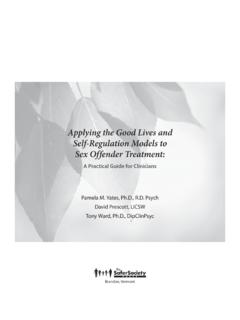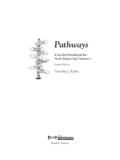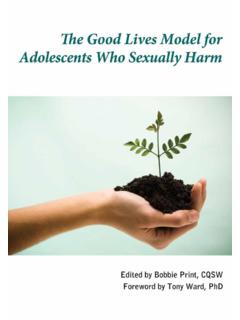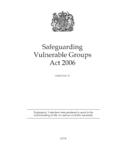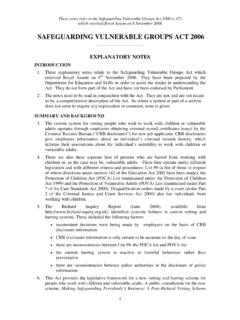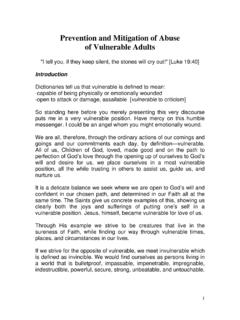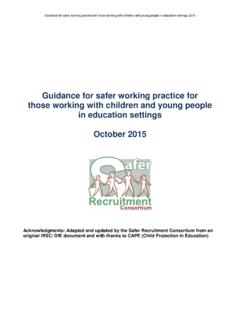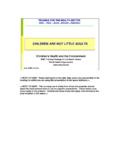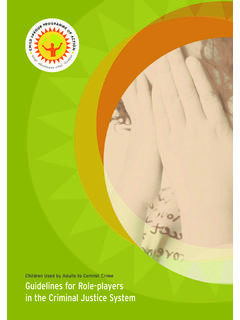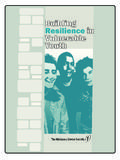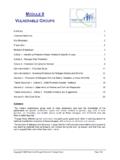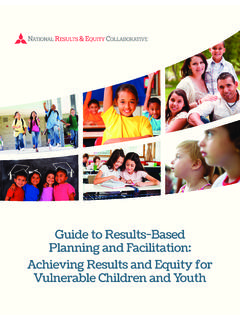Transcription of Do Children Sexually Abuse Other Children? - Safer Society
1 Do Children Sexually Abuse Other Children ?351 Pleasant St, Suite B-319 Northhampton, MA : Pleasant St, Suite B-319 Northhampton, MA : 2007 Stop It Now! All rights part of this publication may be reproduced without written permission from Stop It Now!Design by JKG GroupTo order additional copies, contact:The Safer Society Box 340 Brandon, VT sexual Abuse among Children and youth351 Pleasant St., Suite B-319 Northampton, MA : parents and caregivers, we want to do all we can to protect our Children , while giving them the freedom they need to develop and become healthy adults . Sometimes, the world can feel full of risks, many of them obvious, and others more confusing. In order to strike the right balance between protection and independence for our Children , we adults need the best possible guide is for everyone involved in bringing up Children . It explains that some Children do Sexually Abuse Other Children , describes how we can recognize the warning signs, and outlines some actions we adults can take to prevent sexual Children are our future.
2 We all have a responsibility to protect them. Take action if you are worried that your child, or a child you know, may be Sexually hurting someone. You are not alone. Help is available. Call the Stop It Now! Helpline at to talk confidentially with professionals who have experience working with individuals and families with similar thanks to our colleagues at Stop It Now! UK & Ireland, for permission to use copyrighted material. This is the third edition of this brochure. The two previous versions were Do Children Sexually Abuse Other Children ? published by Stop It Now! in 1999 and Child s Play? Preventing Abuse Among Children and Young People published by Stop It Now! UK & Ireland in people already are aware of the risk of sexual Abuse that some adults present to our Children . There is growing understanding that the vast majority of Children who are Sexually abused, are abused by someone they know, and often trust. Unfortunately, very few adults recognize that Children and adolescents also can present a risk to Other Children .
3 In fact, over a third of all sexual Abuse of Children is committed by someone under the age of can be a difficult issue to address, partly because it is often challenging for adults to think of the Children or adolescents we know as capable of Sexually abusing others. Also, it is not always easy to tell the difference between natural sexual curiosity and potentially abusive behaviors. Children , particularly younger Children , may engage in inappropriate interactions without understanding the hurtful impact it has on others. For this reason, it may be more helpful to talk about a child s Sexually harmful behavior rather than Sexually abusive is essential that all adults have the information needed to recognize potentially harmful activities at an early stage and to seek help so the behaviors can be stopped. Every adult who cares about Children has an opportunity, as both teacher and role model, to show Children how to interact without harming others, either while they are still Children , or later, as adults .
4 adults have the added responsibility of ensuring that all Children who have been involved in a harmful sexual situation, whatever their role, are given the help they need to live healthy productive lives. I didn t have the words to tell my parents what was going on. I said I didn t want to be left alone with kids. I wish they had listened to me. An ADOleSCent wIth SexuAl behAvIOr prOblemSDO Children Sexually Abuse Other Children ?whAt IS heAlthy SexuAl DevelOpment?Most adults understand that Children pass through different stages of development as they grow. Sometimes, adults have more difficulty acknowledging that, from birth, Children are sexual beings. Like Other areas of a child s development, it is normal for Children s awareness and curiosity about their own sexual feelings to change as they pass from infancy into childhood, and then through puberty to child is an individual and will develop in his or her own way. However, there is a generally accepted range of behaviors linked to Children s changing age and developmental stages.
5 These behaviors may include exploration with Other Children of similar power or stature by virtue of age, size, ability or social status. Sometimes, it can be difficult to tell the difference between sexual exploration that is appropriate to a developmental stage and interactions that are warning signs of harmful , adults may need to set limits when Children engage in behaviors we consider inappropriate, even if the Children may be unaware of potential harm. This is a chance to talk with them about keeping themselves and others safe, and to let them know that you are someone they can talk to when they have questions. adults can help Children be comfortable with their sexual development and understand appropriate sexual boundaries, for example, adults can model appropriate, respectful with disabilities or developmental challenges benefit from special attention to their safety. Depending on the nature of their disability, they may develop at different rates, which can make them more vulnerable to being abused.
6 They may also inadvertently harm another child without understanding the hurtful impact of their actions. For example, Children with disabilities sometimes behave Sexually in ways that are out of step with their age. Particular care may be needed to help Children understand their sexual development and to ensure that these Children and their caregivers can communicate effectively about any questions or worries they is important to recognize that, while people from various backgrounds have different expectations about what is acceptable behavior for Children , sexual Abuse is present across all ethnic groups, cultures and religious beliefs. 56 Adapted from Wurtele, and Miller-Perrin, Preventing Sexual Abuse . University of Nebraska Press. Lincoln, NE. chart shows some examples of common sexual behavior that we might anticipate seeing in our Children as they pass through different stages of development from pre-school to adolescence. Remember that each child develops at his or her own pace.
7 Not every child will show all these behaviors at the same stages, or necessarily experience specific behaviors at chart also describes kinds of behavior that are less common in a given developmental stage, and which may give cause for concern. If you feel uneasy or have any questions or concerns about a child you know, talk to someone you trust, like a friend, family member, your healthcare provider, a counselor, or call the Stop It Now! Helpline at a more complete list or if you have any question or concerns about sexual behaviors of a child in your life, please call the confidential, national toll-free Stop It Now! Helpline at harmful behavior by Children and young people may range from experimentation that has gone too far to serious sexual is important for adults to recognize that many Children will engage in some forms of sexual exploration with Children of a similar age, size, social status or power. Sometimes a child or young person may engage in sexual play with a much younger or more vulnerable child, or use force, tricks or bribery to involve someone in sexual activity.
8 While such manipulation may be a cause for concern, it is critical to realize that manipulation may not, in itself, indicate a tendency toward sexual aggression. Professional help and advice is needed to determine the best way to support a child in managing any concerning in mind: Children as young as 4 or 5 may unknowingly engage in Sexually harmful behavior, although more often those who Sexually harm Children are , but not always, the child or young person causing the harm is older than the the child being harmed is uncomfortable or confused about what is happening, but may feel that he or she is willingly involved or to blame for being in the times, one or both Children do not understand that the behavior is harmful. whAt IS Age-ApprOprIA te Or DevelOpmentAlly-expeCteD SexuAl behAvIOr?whAt IS Sexually hArmful behAvIOr?While learning about their bodies and sexuality, Children may behave in ways that seem out of sync with their age or developmental stage.
9 Many minor factors for example, having an older sibling may increase a child s awareness of knowledge, attitudes and behaviors of an older age group. Usually, unexpected behavior can be redirected with a simple instruction. Of particular concern are behaviors involving another child, in which either child seems unable to control the behavior after being asked to (0 to 5 yrs.)Common: Sexual language relating to differences in body parts, bathroom talk, pregnancy and birth. Self stimulation at home and in public. Showing and looking at private body : Discussion of specific sexual acts or explicit sexual language. Adult-like sexual contact with Other Children . School-Age Children (6 to 12 years)May include both pre-pubescent Children and Children who have already entered puberty, when hormonal changes are likely to trigger an increase in sexual awareness and Children :Common: Questions about relationships and sexual behavior, menstruation and pregnancy. Experimentation with same-age Children , often during games, kissing, touching, exhibitionism and role-playing.
10 Private self : Adult-like sexual interactions, discussing specific sexual acts or public self stimulation. After puberty begInS:Common: Increased curiosity about sexual materials and information, questions about relationships and sexual behavior, using sexual words and discussing sexual acts, particularly with peers. Increased experimenting including open-mouthed kissing, body-rubbing, fondling. Masturbating in : Consistent adult-like sexual behavior, including oral/genital contact and intercourse. Masturbating in public. Adolescence (13 to 16)Common: Questions about decision making, social relationships, and sexual customs. Masturbation in private. Experimenting between adolescents of the same age, including open-mouthed kissing, fondling and body rubbing, oral/genital contact. Also, voyeuristic behaviors are common. Intercourse occurs in approximately on third of this age : Masturbating in public and sexual interest directed toward much younger is a growing problem of sexual images of Children being available for viewing and downloading on the Internet.
